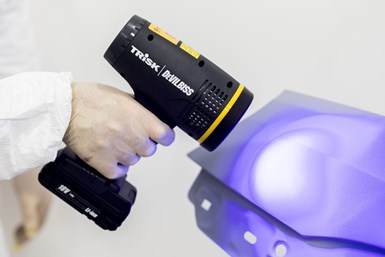Advantages of UV-LED Spot Curing for Collision Repair
Appears in Print as: 'Be Spot On with UV-LED Spot Curing for Collision Repair'
Carlisle Fluid Technologies’ Jacob Fortmeyer shares advantages, considerations and important equipment features for the UV-LED curing process.
#asktheexpert
Unlike many traditional coatings and fillers, UV-cured materials will not cure on their own until exposed to UV light at a specific wavelength and minimum energy intensity. Photo Credit: Carlisle Fluid Technologies
Q: Why are more collision repair shops using ultraviolet (UV) curing as part of their repair processes?
Speed and efficiency
Repair time per car and cars completed per day are two of the most critical key performance indicators (KPIs) for modern repair shops, and UV curing boosts both. Body fillers, primers and clear coats can be fully cured in as little as 30-120 seconds, versus the 15-30 minutes of traditional heat or infrared (IR)-based methods. UV curing can also be done outside the paint booth, freeing up the most valuable asset in the shop for its primary use.
Featured Content
VOC reduction
UV coatings and fillers do not rely on the evaporation of solvents to bond and harden, resulting in significantly lower volatile organic compounds (VOCs). Some formulations are even 100% solvent free and have zero VOC emissions during curing. This makes hitting ever more stringent VOC regulations significantly easier.
Increased offerings
Coating and body filler manufacturers have significantly expanded their UV-cure range of products in recent years, in large part because of the benefits already mentioned. While in the past it could sometimes be difficult to find an exact UV substitute for your existing product, the breadth of offerings today can cover almost any requirement.
Q: What are the major considerations before making the switch to UV curing?
Curing coverage
Unlike many traditional coatings and fillers, UV-cured materials will not cure on their own until exposed to UV light at a specific wavelength and minimum energy intensity. This means the consequences of “missing a spot” while curing can be severe, as rework of the repair area will almost always be required. Ensuring operators are properly trained to expose all areas of the repair for the minimum required curing time is key to maintaining quality.
Safety
There are two primary curing wavelengths on the market, 365 nm and 395 nm. 365 nm equipment uses primarily older technology and is significantly more dangerous for any exposed skin and eyes. Most modern UV-LED curing equipment uses 395 nm curing, which, because of its closer proximity to the visible light spectrum, is much safer for operators. It is important to select equipment with quality LEDs that emit almost all light at exactly 395 nm, as lower-quality equipment tends to emit across a spectrum of more dangerous wavelengths, which increases safety risks for operators.
Q: What features should I look for in UV curing equipment?
Consistent light intensity
UV coatings and fillers will only cure once the proper light wavelength and energy intensity conditions are met. A common problem with lower-quality UV equipment is that they emit high energy intensity in the center of their light pattern but are very weak around the edges. This increases the risk that the edges of the repair area will not be fully cured, and therefore results in rework. UV equipment that has consistent intensity over the entire pattern, not just in the middle, should be selected.
Consistent power output
Battery-powered UV-LED offerings are popular because of their portability and light weight. However, the battery can become the weak link as its charge is depleted, just like power tools that slow down as the battery dies.. But unlike power tools, because UV light is invisible to the naked eye, an operator cannot tell that the UV equipment is now emitting less power and will require more time to fully cure. You should select equipment with purpose-built batteries that provide consistent amperage from full charge to depleted, so your operator doesn’t have to adjust their curing process based on battery charge.
About the Author
Jacob Fortmeyer is the Auto Refinish SBU Director for Carlisle Fluid Technologies. Visit carlisleft.com.
RELATED CONTENT
-
Precise Paint Flow Reduces Material and Labor Costs
Finding a more accurate paint proportioner for its application enabled this auto parts manufacturer to save significant costs and labor while increasing capacity.
-
Choosing Paint for Fast-Paced, Extra Slip, High Temp Applications
Many industrial applications require coatings that not only offer corrosion resistance and aesthetics, but provide additional attributes such as heat resistance and quick drying properties. This helpful clinic offers a few examples.
-
Optimizing Your Liquid Electrostatic System
For your electrostatic process to work consistently, there are three primary items to check: voltage at the applicator, part grounding, and compatibility of the coating material. John Owed of Carlisle Fluid Technologies walks you through the process.




















